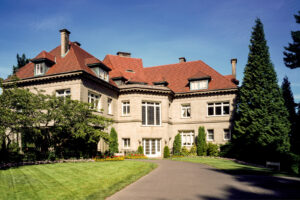Fall is a great time for your clients to prepare their lawn for winter.
Taking advantage of cool fall weather to fertilize, control weeds, and improve the health and appearance of their yard will boost curb appeal come spring!
We asked Carson Arthur, Better Homes and Gardens® Real Estate Outdoor Design Expert to share a few of his winter yard-care secrets to help any lawn get prepped for the colder months ahead.
Tips to Help Homeowners Prepare for Winter
1. Should you fertilize before the first snow and then how often during the winter should you fertilize (if at all)?
 This is a tricky question and the answer depends on where you live. For states in the south that plant warm-weather grasses, using a fertilizer with a high middle and end number (0-20-20) has been proven to help plants with strong root growth.
This is a tricky question and the answer depends on where you live. For states in the south that plant warm-weather grasses, using a fertilizer with a high middle and end number (0-20-20) has been proven to help plants with strong root growth.
For the northern states, no research has shown any benefit of fall or winter fertilization. I would suggest trying a fertilizer and then taking a few pictures of the grass in spring to see if it helped with growth.
One thing to remember, don’t apply any fertilizer containing nitrogen in the fall.
Nitrogen is used for leaf growth, not exactly where you want your plants expending energy at the end of the season.
2. It’s a common misunderstanding that once winters hits, all yard work ends. How do you suggest gardeners tackle yard work during the winter?
Winter is a difficult time of year for many gardeners. There are several different opinions as to what should be done during the winter months.
Some gardeners advocate leaving all the plants alone as the different grasses and dried flowers create winter interest. Others promote the idea that fall and winter is the time to prune and get prepped for spring.
Either option has merits; pick the one that works best for you!
3. How can homeowners avoid damage to their lawn during the winter months?
BEWARE OF THE SALT! When it comes to grass, piling the snow from the driveway after you have laced it with ice salt is the harshest thing you can do to your lawn.
If you find that come spring you have lots of yellow and burnt grass along the edges of the drive or road, then you know exactly what’s happened. Try using salt-tolerant fescues as a safe option.
4. Is it wise to reseed just before winter?
I am a huge fan of reseeding before winter. The best way to top-dress your lawn is to mix one bag of grass seed with one bag of soil in a wheelbarrow. This seed-to-soil contact is what helps grass grow.
I plant this mix right up until first frost. Usually, the ground freezes 3-4 weeks after that point which gives your seed a chance to get started.
5. My understanding is that pruning promotes growth and should be done in the spring, yet many feel you should prune your plants prior to the winter months. What is your best advice?
Pruning is very specific to the plant. You can do a lot of damage to certain plants if you prune them at the wrong time of year.
For example, certain hydrangeas want to be trimmed in fall, others in the spring. When in doubt, always do your research first!
6. What are your top tips for homeowners with a new, less established yard?
- Get a complete design done first! That way you can take your time building your outdoor spaces but you’ll have an end goal that you are working towards.
- Do your research! Go around your neighborhood and take pictures of plants that are doing well. If your neighbors can grow them, you probably can too!
- Stay on budget! Landscaping can add 10-15{0a8e414e4f0423ce9f97e7209435b0fa449e6cffaf599cce0c556757c159a30c} to your home’s value. If you invest more than that in your yard, you won’t see a return. Get an approximate price for your home, and budget 10{0a8e414e4f0423ce9f97e7209435b0fa449e6cffaf599cce0c556757c159a30c} of that for outdoor upgrades.
[ois skin=”Subscribe 1″]







